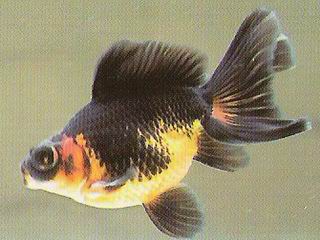Goldfish - Telescope
Telescope , Globe Eye, Dragon Eye Goldfish Scientific Name: Carassius auratus
Tue, 15th July, 2025 - 10:10 pm GMT
Sponsor Ads:

Alternative Name
Telescope , Globe Eye, Dragon Eye Goldfish Scientific Name: Carassius auratusBasic Info
Telescope Goldfish are usually between six and eight inches long. They have beautifully full fins, and forked caudal fins. The distinguishing feature of the Telescope Goldfish is its large protruding eyes. These should be even on each side of the fish's head. Some Telescopes have eyes that bulge three quarters of an inch from their heads. There are different eye shapes and types available for Telescope Goldfish. They also come in different scale types: metallic, pearl, matte, and nacreous, a mix of matte and metallic scales, are all common. These goldfish may be white, orange, or calico. There is also a solid black matte variety, which is usually referred to as a Black Moor, or simply Moor. Varieties of Telescope Goldfish that lack scales are also available.
Health
Specific Care Information: Relative Care Ease: Average The Telescope Goldfish should usually be kept in water temperatures in the lower 70 degrees Fahrenheit. The pH should be between 6.8 and 7.2. No sharp or protruding objects should be present in the tank, as their eyes may become easily injured. Although Telescope Goldfish often live peacefully with others, they should not be kept with competitive fish due to their easily damaged nature. A diet based on fresh spinach, peas, lettuce, and zucchini should be supplemented with frozen vegetable diet, plankton, brine shrimp, glass worms, blood worms, bits of beef heart, and daphnia. Although Telescope Goldfish generally do well on pellet or tablet food, a more natural diet is often preferred.Habitat
Fresh water fishBehavior
With their bulging eyes, the Telescope Goldfish may require a second glance. Upon closer examination, these beautiful fish are often so taking that many people decide these goldfish will be essential additions to their aquariums. When they are not feeding, Telescope Goldfish usually remain in the middle levels of their aquaria. They are peaceful, known for their docility, and may form schools with other fish. Because Telescope Goldfish tend to have bad eyesight, they usually forage for food that falls to the bottom of their habitat. Because their eyes can be damaged by contact with sharp objects on the enclosure floor, or anywhere in the enclosure, such items should not be placed in the tank. Because many people value the unique appearance of the Telescope Goldfish, many choose to feed them color or growth enhancing diets.Origin
ChinaHistory
Most breeds of fancy goldfish, including the Telescope Goldfish, have their origins in China. They have probably been domesticated for more than 1,000 years. In the 1500's, Japan became a major center for the breeding of fancy goldfish as well. By the late 1800's, the breeding of goldfish became a European pastime as well. Today, the Telescope Goldfish is a fancy goldfish that is adored by many fanciers.Common Foods
N/ASponsor Ads:
No name, no matter how simple, can be correctly understood over the phone. -- Unknown
Goldfish - Telescope
Coded by: BGID® | ALL RIGHTS RESERVED Copyright © 2000-2025
Disclaimer | Privacy | Report Errors / Contact | Credits








 Preparing For China. China is growing their military. China Military Technology - can it keep up with the US?
Preparing For China. China is growing their military. China Military Technology - can it keep up with the US?  versus
versus 

 versus
versus 
 This Thread is about the North Korean Military itself - the kind of army, navy, and air force they have.
This Thread is about the North Korean Military itself - the kind of army, navy, and air force they have. 
 versus
versus 
 versus
versus  versus
versus